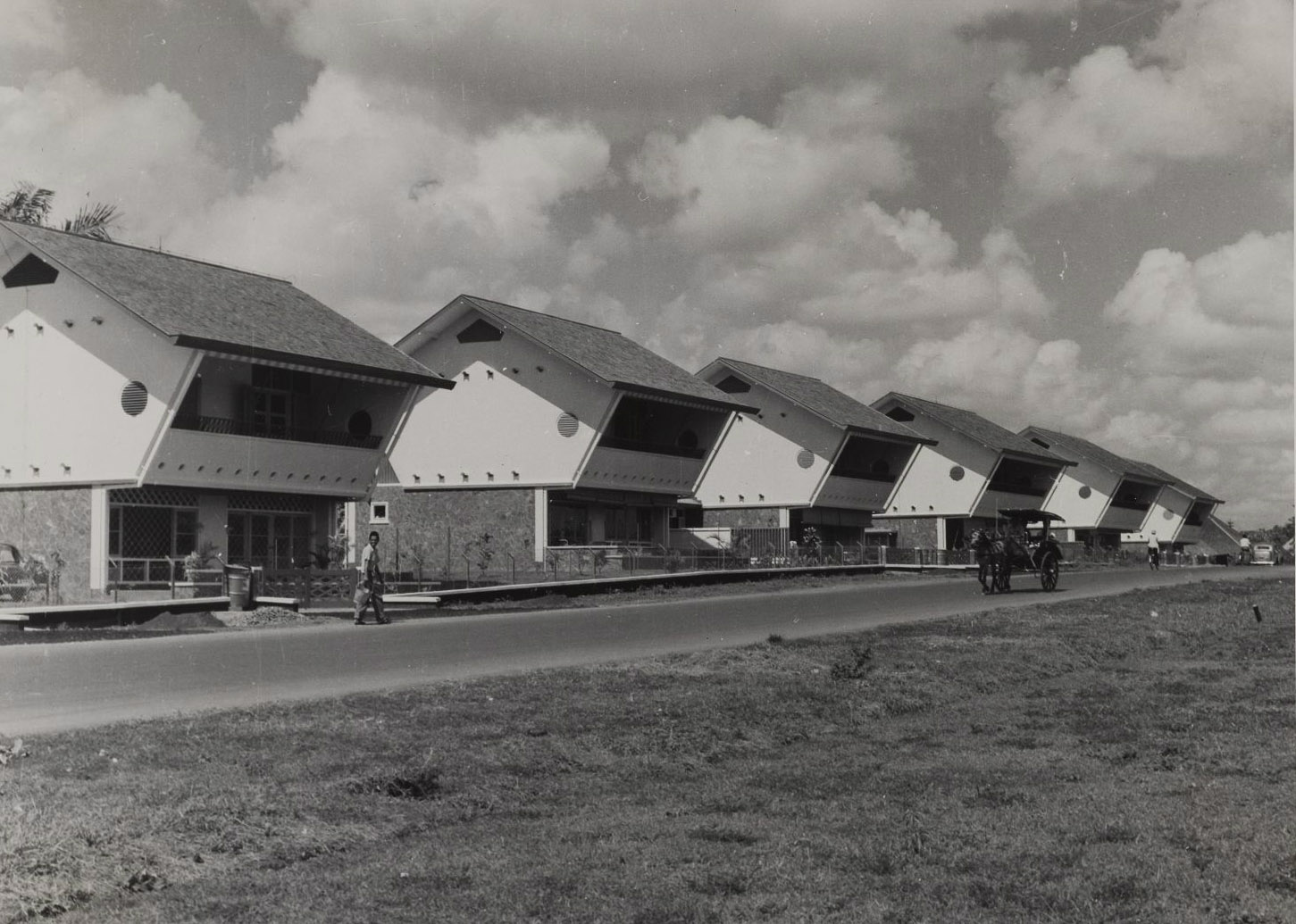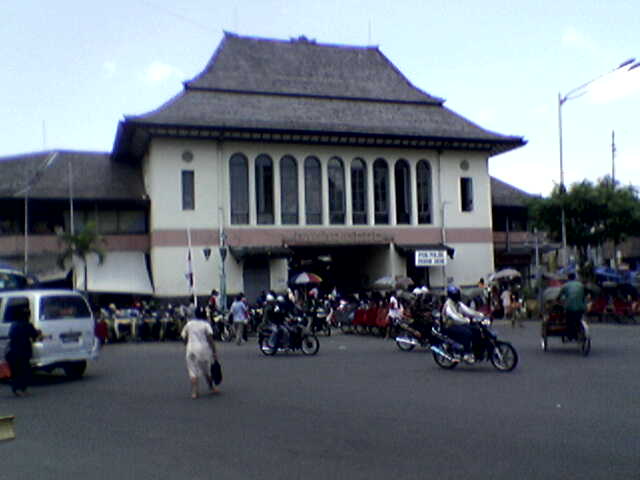|
Kebayoran Baru
Kebayoran Baru is a district ( id, kecamatan) of South Jakarta, Indonesia. The name of the district was derived from an area which was developed in the post-war period as a new suburb town of Jakarta, Kebayoran Baru. Kebayoran Baru was the last residential area to be developed by the Dutch colonial administration. The urban planning was laid in a concept of the Garden city movement, consisting of a well-planned residential area, a shopping center, and a business district, supported with civic facilities e.g. schools, places of worship, hospitals, and parks. Many important governmental institutions are located in Kebayoran Baru, such as the Indonesia Stock Exchange building, the ASEAN Secretariat building, the Criminal Investigation Agency of the National Police, and the City Hall of South Jakarta. Sudirman Central Business District is also located in Kebayoran Baru sub-district. Toponym Kebayoran Baru means "New Kebayoran". The word ''kebayoran'' is derived from ''kabayuran'', mea ... [...More Info...] [...Related Items...] OR: [Wikipedia] [Google] [Baidu] |
List Of Districts Of Jakarta
The Special Capital Region of Jakarta in Indonesia is divided into 5 ''kota'' or municipalities and one ''kabupaten'' or Regencies of Indonesia, regency, which in turn are divided administratively into List of districts of Indonesia, districts, known as ''kecamatan''. In total, there are 44 districts in Jakarta, a number that has remained since the most recent administrative change in 2001. South Jakarta and East Jakarta are tied with the largest number of districts with 10 each, while the Thousand Islands Regency has the least with just 2. List West Jakarta Central Jakarta South Jakarta East Jakarta * Cakung * Cipayung * Ciracas * Duren Sawit * Jatinegara * Kramat Jati * Makasar * Matraman * Menteng * Pasar Rebo * Pulo Gadung North Jakarta * Cilincing * Kelapa Gading * Koja * Pademangan * Penjaringan * Tanjung Priok Thousand Islands * Kepulauan Seribu Selatan * Kepulauan Seribu Utara References {{DEFAULTSORT:Districts of Jakarta Districts of Jakarta, Lists ... [...More Info...] [...Related Items...] OR: [Wikipedia] [Google] [Baidu] |
Kelurahan
In Indonesia, village or subdistrict is the fourth-level subdivision below a district, regency/city, and province. There are a number of names and types for villages in Indonesia, with ''desa'' (rural village) being the most frequently used for regencies and ''kelurahan'' (urban village) for cities. According to the 2019 report by the Ministry of Home Affairs, there are 8,488 urban villages and 74,953 rural villages in Indonesia. Types of villages ''Kelurahan'' ''Kelurahan'' is an urban village terminology primarily used in cities, but also tiny parts of regencies. It is commonly translated to English as subdistrict. The leader of ''kelurahan'' is called ''lurah''. A ''lurah'' is a civil servant appointed by the district head. According to the Regulation of the Minister of Home Affairs Number 31 of 2006, a ''kelurahan'' can be created with the following criteria: *Java and Bali: having at least 4,500 residents or 900 families within an area of at least 3 km2. *Sumatra and Su ... [...More Info...] [...Related Items...] OR: [Wikipedia] [Google] [Baidu] |
Kodomo Mikoshi, Ennichisai, Blok M, Jakarta
{{Disambig ...
''Kodomo'' is the Japanese word for child. Kodomo may also refer to: * Kodomo (musician), the moniker for electronic musician Chris Child * Children's anime and manga or kodomo, manga with a target demographic of children * Kodomo, a toothpaste brand from Lion Corporation See also * Komodo (other) Komodo may refer to: Computers * Komodo Edit, a free text editor for dynamic programming languages * Komodo IDE an integrated development environment (IDE) for dynamic programming languages * Komodo (chess), a chess engine People * Komodo ... [...More Info...] [...Related Items...] OR: [Wikipedia] [Google] [Baidu] |
Semanggi Interchange
Semanggi Interchange ( id, Simpang Susun Semanggi) or commonly known as Semanggi Bridge () is a major road interchange in Jakarta, Indonesia which consists of a cloverleaf interchange (hence , "clover")—the first, and until the 1990s the only, of its kind in Indonesia—and a partial turbine interchange. Two main roads of the city Gatot Subroto Road and Sudirman Road intersect at this interchange. Initially completed in 1962 as part of several projects intended to be completed before the 1962 Asian Games, the interchange is a landmark and an important part of the Golden Triangle of Jakarta. History 1960-1962 This interchange was built in the 1960s as the part of infrastructure development for 1962 Asian Games and Sukarno's vision to make Jakarta as the beacon of a new and powerful nation of Indonesia. The Semanggi Interchange area was previously a swamp area filled with clover trees. David Gee Cheng, the Indonesian Deputy Minister for City Planning and Construction, ... [...More Info...] [...Related Items...] OR: [Wikipedia] [Google] [Baidu] |
Central Jakarta
Central Jakarta ( id, Jakarta Pusat) is one of the five administrative cities () which form the Special Capital Region of Jakarta. It had 902,973 inhabitants according to the 2010 censusBiro Pusat Statistik, Jakarta, 2011. and 1,056,896 at the 2020 census. Central Jakarta is not self-governed and does not have a city council, hence it is not classified as a proper municipality. Central Jakarta is the smallest in area and population of the five cities of Jakarta. It is both the administrative and political center of Jakarta and Indonesia. Central Jakarta contains a number of large international hotels and major landmarks such as Hotel Indonesia. Districts Central Jakarta is bounded by North Jakarta to the north, East Jakarta to the east, South Jakarta to the south, and West Jakarta to the west. It is subdivided into eight districts (), listed below with their areas and their populations at the 2010 census. Demographics Central Jakarta has an average of 20,177 residents per s ... [...More Info...] [...Related Items...] OR: [Wikipedia] [Google] [Baidu] |
Jalan M
''Jalan'' ( ur, , lit=Jealousy) is a Pakistani television series premiered on ARY Digital on 17 June 2020. It is directed by Aabis Raza and produced by Fahad Mustafa and Dr. Ali Kazmi under Big Bang Entertainment. It stars Minal Khan, Areeba Habib, Emmad Irfani and Fahad Sheikh. The first teaser of the series premiered on 3 June 2020. The serial received huge criticism due to its misogynistic and regressive approach. Plot Nisha(Minal Khan) and Misha(Areeba Habib) are two sisters who belong to a middle-class background. Nisha is a selfish girl who is used to snatching better things from her sister which Misha gives her happily. Misha is nicknamed Meenu by her family. Nisha likes her cousin Ahmer( Fahad Sheikh ) who loves her intensely and becomes engaged to her. Later Asfandyar's( Emaad Irfani ) proposal comes for Meenu. Seeing that Asfandyar comes from a rich and elite background, Nisha becomes jealous of her sister and tries to point out flaws in him, but the two eventually g ... [...More Info...] [...Related Items...] OR: [Wikipedia] [Google] [Baidu] |
WordPress
WordPress (WP or WordPress.org) is a free and open-source content management system (CMS) written in hypertext preprocessor language and paired with a MySQL or MariaDB database with supported HTTPS. Features include a plugin architecture and a template system, referred to within WordPress as "Themes". WordPress was originally created as a blog-publishing system but has evolved to support other web content types including more traditional mailing lists and Internet fora, media galleries, membership sites, learning management systems (LMS) and online stores. One of the most popular content management system solutions in use, WordPress is used by 42.8% of the top 10 million websites . WordPress was released on May 27, 2003, by its founders, American developer Matt Mullenweg and English developer Mike Little, as a fork of ''b2/cafelog''. The software is released under the GPLv2 (or later) license. To function, WordPress has to be installed on a web server, either part of ... [...More Info...] [...Related Items...] OR: [Wikipedia] [Google] [Baidu] |
Pejompongan
Pejompongan is a residential area located north of Gelora Bung Karno Sports Complex, and in the east area of Slipi in Jakarta, Indonesia. This area was built as residential area for upper middle-class government employees and employees of other state institutions since 1950s. Pejompongan region Administratively located in the District of Tanah Abang and mostly located in the Village of Bendungan Hilir. Historically, the development of Pejompongan started with the plan to build clean water treatment Water treatment is any process that improves the Water quality, quality of water to make it appropriate for a specific end-use. The end use may be drinking water, drinking, industrial water supply, irrigation, river flow maintenance, water recrea ... in the area of central Jakarta. The first WTP was built in 1957. To improve the quality of raw water air supply, the city later built another plan in 1966. Pejompongan area is also known for its unique and exotic culinary choices. Referen ... [...More Info...] [...Related Items...] OR: [Wikipedia] [Google] [Baidu] |
Dutch East Indies
The Dutch East Indies, also known as the Netherlands East Indies ( nl, Nederlands(ch)-Indië; ), was a Dutch colony consisting of what is now Indonesia. It was formed from the nationalised trading posts of the Dutch East India Company, which came under the administration of the Dutch government in 1800. During the 19th century, the Dutch possessions and hegemony expanded, reaching the greatest territorial extent in the early 20th century. The Dutch East Indies was one of the most valuable colonies under European rule, and contributed to Dutch global prominence in spice and cash crop trade in the 19th to early 20th centuries. The colonial social order was based on rigid racial and social structures with a Dutch elite living separate from but linked to their native subjects. The term ''Indonesia'' came into use for the geographical location after 1880. In the early 20th century, local intellectuals began developing the concept of Indonesia as a nation state, and set the stage ... [...More Info...] [...Related Items...] OR: [Wikipedia] [Google] [Baidu] |
Netherlands
) , anthem = ( en, "William of Nassau") , image_map = , map_caption = , subdivision_type = Sovereign state , subdivision_name = Kingdom of the Netherlands , established_title = Before independence , established_date = Spanish Netherlands , established_title2 = Act of Abjuration , established_date2 = 26 July 1581 , established_title3 = Peace of Münster , established_date3 = 30 January 1648 , established_title4 = Kingdom established , established_date4 = 16 March 1815 , established_title5 = Liberation Day (Netherlands), Liberation Day , established_date5 = 5 May 1945 , established_title6 = Charter for the Kingdom of the Netherlands, Kingdom Charter , established_date6 = 15 December 1954 , established_title7 = Dissolution of the Netherlands Antilles, Caribbean reorganisation , established_date7 = 10 October 2010 , official_languages = Dutch language, Dutch , languages_type = Regional languages , languages_sub = yes , languages = , languages2_type = Reco ... [...More Info...] [...Related Items...] OR: [Wikipedia] [Google] [Baidu] |
Thomas Karsten
Herman Thomas Karsten (22 April 1884, Amsterdam – 1945, Cimahi) was a Dutch engineer who gave major contributions to architecture and town planning in Indonesia during Dutch colonial rule. Most significantly he integrated the practice of colonial urban environment with native elements; a radical approach to spatial planning for Indonesia at the time. He introduced a neighborhood plan for all ethnic groups in Semarang, built public markets in Yogyakarta and Surakarta, and a city square in the capital Batavia (now 'Jakarta'). Between 1915 and 1941 he was given responsibility for planning 12 out of 19 municipalities in Java, 3 out of 9 towns in Sumatra and a town in Kalimantan (Indonesian Borneo). He received official recognition from both the government through his appointment to the colony's major Town Planning Committee and by the academic community with his appointment to the position of Lecturer for Town Planning at the School of Engineering at Bandung. He died in an internm ... [...More Info...] [...Related Items...] OR: [Wikipedia] [Google] [Baidu] |





